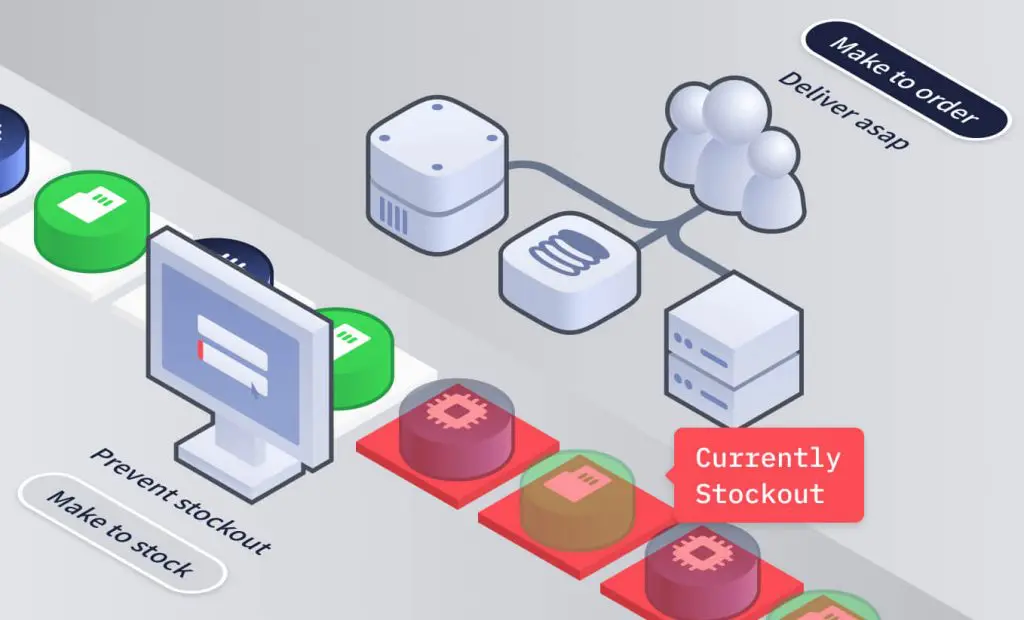As businesses strive to stay competitive and meet customer expectations in an ever-changing market, demand management has emerged as a crucial strategy for success in 2024 and beyond. This comprehensive guide aims to provide a thorough understanding of demand management, its significance, and its practical applications across various industries. In today’s fast-paced and customer-centric environment, managing demand effectively is no longer an option but a necessity. Companies must navigate fluctuating consumer preferences, market trends, and supply chain complexities to ensure they can deliver the right products, at the right time, and at the right place. Demand management equips organizations with the tools and strategies to anticipate and respond to these dynamic conditions, enabling them to optimize their operations, reduce costs, and enhance customer satisfaction.
What is Demand Management
Demand management is a comprehensive approach that enables businesses to understand, predict, and influence customer demand for their products or services. It involves a systematic process of collecting and analyzing data, forecasting demand patterns, and implementing strategies to align production, inventory, and supply chain operations with anticipated customer needs. The importance of demand management lies in its ability to bridge the gap between supply and demand, ensuring that companies can meet customer expectations while minimizing waste, overproduction, and excess inventory. By accurately forecasting demand, businesses can optimize their production schedules, inventory levels, and supply chain logistics, resulting in cost savings, improved efficiency, and enhanced customer satisfaction.
The Role of Demand Management
Demand management plays a pivotal role in helping companies understand, predict, and influence customer demand to optimize production and inventory. Through a data-driven approach, businesses can gain insights into customer preferences, buying patterns, and market trends, enabling them to make informed decisions about product development, pricing strategies, and marketing campaigns. By accurately forecasting demand, demand management allows companies to align their production schedules and inventory levels with anticipated customer needs. This not only minimizes the risk of overproduction or stock-outs but also ensures that products are available when and where customers need them, enhancing customer satisfaction and loyalty. Furthermore, demand management helps businesses influence customer demand through targeted marketing campaigns, promotions, and pricing strategies. By understanding customer segments and preferences, companies can tailor their offerings and messaging to stimulate demand or shift it towards more profitable products or services.
Demand Management in Logistics
Demand management is particularly crucial in the realm of logistics, encompassing transportation, warehousing, and distribution. By accurately forecasting demand, businesses can optimize their logistics operations, reducing transportation costs, minimizing inventory holding costs, and improving overall supply chain efficiency. For example, with accurate demand forecasts, companies can plan and schedule transportation routes more effectively, consolidating shipments and minimizing empty miles. Additionally, demand management enables businesses to optimize warehouse space utilization, ensuring that the right products are stored in the right locations to facilitate efficient picking and packing processes. By aligning logistics operations with anticipated demand, companies can achieve significant cost savings, reduce lead times, and improve customer service levels, ultimately enhancing their competitiveness in the market.
Objectives and Purposes of Demand Management
The primary objectives and purposes of demand management are multifaceted, encompassing various aspects of business operations and customer satisfaction.
Accurate Forecasts
One of the fundamental objectives of demand management is to generate accurate demand forecasts. By leveraging historical data, market intelligence, and advanced analytical techniques, businesses can predict future demand patterns with greater precision. Accurate forecasts enable companies to reduce waste and overproduction. This can be done by aligning production schedules with anticipated demand. Businesses should also optimize inventory levels, which minimizes stockouts and excess inventory holding costs. Additionally, the supply chain should also be streamlined. This can be done by coordinating the flow of materials and finished goods based on demand.
Read our case study on how one US company streamlined its replenishment operations with Intuendi AI.
Inventory and Cost Optimization
Effective demand management strategies aim to optimize inventory levels and reduce overall costs associated with inventory management. By maintaining a balanced inventory, businesses can not only avoid stock surpluses that tie up capital and increase holding costs but also prevent stock shortages that can lead to lost sales and dissatisfied customers. Furthermore, they are able to minimize obsolete inventory, which in turn, reduces the need for markdowns or write-offs. Carrying costs, such as storage, handling, and insurance expenses can also be reduced.
Improving Customer Experience
A crucial objective of demand management is to enhance the customer experience by ensuring that products are available when and where customers need them. By accurately forecasting demand and aligning supply chain operations, businesses can ensure that they maintain sufficient stock levels to meet customer demand promptly. They are also able to reduce lead times and improve delivery times, meeting customer expectations for speed and convenience. An added benefit is that they are able to offer a wider range of products and variations to cater to diverse customer preferences. By providing a consistent and reliable shopping experience, businesses go a long way in fostering customer loyalty and trust.
Do you want to learn how to pbtain sustainable growth by increasing the range of products in your catalog while maintaining a lean inventory? Download our free eBook:
Efficient Stock Planning and Warehouse Management
Demand management plays a vital role in optimizing stock planning and warehouse management. By accurately forecasting demand, businesses can determine the appropriate stock levels for each product, minimizing excess inventory and stockouts. They are able to better plan warehouse layouts and storage locations based on anticipated demand patterns, improving picking and packing efficiency. Furthermore, inbound and outbound logistics can be coordinated, ensuring timely replenishment of stock and prompt order fulfillment. The implementation of lean inventory management practices has the benefit of reducing carrying costs and improving cash flow. Through efficient stock planning and warehouse management, companies can enhance their overall operational efficiency, reduce costs, and provide better service to their customers.
Demand Management vs. Demand Planning
While demand management and demand planning are closely related concepts, they are distinct processes with different scopes and objectives. Understanding the differences and how they complement each other is crucial for effective business operations. Demand planning is a subset of demand management, focused specifically on forecasting future demand. It involves collecting and analyzing data from various sources, such as historical sales, market trends, and customer preferences, to generate accurate demand forecasts. Demand planning aims to predict what products or services will be in demand, in what quantities, and at what times. Demand management, on the other hand, is a broader and more comprehensive approach that encompasses demand planning as well as other activities. In addition to forecasting, demand management involves strategies to influence and shape customer demand through marketing, pricing, promotions, and product development. It also includes the alignment of supply chain operations, production schedules, and inventory levels with the forecasted demand.
While demand planning provides the foundation for understanding future demand, demand management goes a step further by developing and executing strategies to optimize supply and operations based on those forecasts. Demand management not only predicts demand but also proactively manages it to achieve business objectives such as cost reduction, inventory optimization, and improved customer satisfaction. By combining demand planning and demand management, businesses can gain a comprehensive understanding of customer needs and market trends, as well as the ability to shape demand and align their operations accordingly. Demand planning informs demand management strategies, while demand management ensures that the forecasted demand is met efficiently and effectively.
Demand Management vs. Capacity Management
Demand management and capacity management are two closely related but distinct concepts that play crucial roles in business strategy and operations. While demand management focuses on understanding and influencing customer demand, capacity management is concerned with aligning the organization’s production or service capabilities with that demand. Demand management involves forecasting customer demand, shaping demand through marketing and pricing strategies, and aligning supply chain operations to meet that demand efficiently. It aims to ensure that products or services are available when and where customers need them while minimizing waste, overproduction, and excess inventory. Capacity management, on the other hand, deals with managing the organization’s resources, such as production facilities, equipment, personnel, and technology, to meet the forecasted demand. It involves determining the optimal level of capacity required to satisfy customer demand while minimizing costs and maximizing profitability.
The interaction between demand management and capacity management is critical for developing an effective business strategy. Demand management provides insights into future customer demand, which informs capacity planning decisions. Based on demand forecasts, organizations can determine whether they need to increase or decrease production capacity, invest in new equipment or facilities, or adjust staffing levels. Conversely, capacity constraints may influence demand management strategies. If an organization has limited production capacity, it may need to prioritize certain products or customer segments, implement demand-shaping strategies (such as promotions or pricing adjustments), or explore outsourcing or partnering options to meet excess demand. By aligning demand management and capacity management, businesses can achieve a balance between customer demand and production capabilities, ensuring that they can meet customer needs efficiently and cost-effectively. This synergy between understanding and shaping demand, and managing the organization’s capacity to fulfill that demand, is essential for long-term business success and competitiveness.
Components and Process of Demand Management
Demand management is a multifaceted process that involves various components and activities, each playing a crucial role in ensuring the effective alignment of supply and demand. This section introduces the key components and processes involved in demand management.
Data Collection and Modeling
Accurate demand management hinges on the availability of reliable and comprehensive data. The first step in the process involves collecting data from various sources, such as historical sales records, market research, customer surveys, and external data sources like economic indicators and industry trends. Once the data is gathered, it needs to be modeled and analyzed to extract meaningful insights. This may involve techniques like time-series analysis, regression modeling, or machine learning algorithms to identify patterns, trends, and correlations that can inform demand forecasting. Effective data collection and modeling lay the foundation for accurate demand forecasts and enable businesses to make informed decisions about production, inventory, and supply chain operations.
Demand Forecasting with Predictive Analysis
At the core of demand management is the process of demand forecasting, which involves using predictive analysis techniques to anticipate future demand for products or services. This component builds upon the data collected and modeled in the previous step. Predictive analysis techniques, such as statistical forecasting models, machine learning algorithms, and simulation models, are employed to analyze historical data, trends, and external factors to generate demand forecasts. These forecasts can be made at different levels of granularity, such as product-level, regional, or customer segment-level, depending on the business requirements. Accurate demand forecasting is crucial for optimizing production schedules, inventory levels, and supply chain operations, as well as informing strategic decisions related to product development, pricing, and marketing.
Find out how Intuendi can help your business with demand forecasting and predictive analytics.
Inventory Planning Using Forecasting Results
The demand forecasts generated through predictive analysis serve as the foundation for inventory planning. This component involves determining the optimal inventory levels for each product or product category to meet the anticipated demand while minimizing excess stock or stock-outs. Inventory planning involves techniques such as safety stock calculations, reorder point calculations and inventory optimization models. These techniques take into account factors like lead times, demand variability, and service level targets to ensure that the right products are available in the right quantities at the right time. Effective inventory planning based on demand forecasts helps businesses reduce inventory carrying costs, minimize waste and obsolescence, and improve customer service levels by ensuring product availability.
Writing and Executing a Supply Chain Plan
The final component of the demand management process is the creation and execution of a comprehensive supply chain plan. This plan integrates demand forecasts, inventory planning, and other operational considerations to optimize the flow of materials, products, and information throughout the supply chain. The supply chain plan outlines the steps and strategies for sourcing raw materials, managing production schedules, coordinating transportation and logistics, and ensuring efficient distribution to meet the forecasted demand. It may also involve collaboration with suppliers, partners, and customers to align operations and improve visibility across the supply chain. Executing the supply chain plan requires effective communication, coordination, and continuous monitoring to adapt to changing demand patterns or disruptions. Regular performance evaluations and adjustments to the plan may be necessary to maintain supply chain agility and responsiveness.
Activities in Demand Management
Demand management is a comprehensive process that encompasses several key activities. These activities are interconnected and work together to ensure that businesses can effectively align their operations with customer demand. The main activities involved in demand management include gathering relevant data from various sources, such as historical sales records, market research, customer surveys, and external data sources such as economic indicators and industry trends. This data serves as the foundation for demand forecasting and analysis. The collected data is then analyzed, using statistical techniques, machine learning algorithms, and modeling tools to identify patterns, trends, and correlations. This analysis helps businesses understand the factors influencing customer demand and provides insights for demand forecasting.
Demand Forecasting is the utilization of predictive analytics and forecasting models to anticipate future demand for products or services. This activity involves incorporating historical data, market trends, and external factors to generate accurate demand forecasts at different levels of granularity (e.g., product-level, regional, or customer segment level). Based on the demand forecasts, businesses are able to determine the optimal inventory levels for each product or product category. This activity involves techniques such as safety stock calculations, reorder point calculations, and inventory optimization models to ensure that the right products are available in the right quantities at the right time. The next step is supply chain planning. This involves creating and executing a comprehensive supply chain plan that integrates demand forecasts, inventory planning, and other operational considerations. This plan outlines strategies for sourcing materials, managing production schedules, coordinating transportation and logistics, and ensuring efficient distribution to meet the forecasted demand.
In order to align customer demand with the organization’s operational capabilities and strategic objectives, demand shaping should be incorporated. This entails implementing strategies to influence and shape customer demand, such as marketing campaigns, promotions, pricing adjustments, and product development initiatives. This should be followed up by regular monitoring of the performance of demand management activities, and an evaluation of the accuracy of forecasts. In so doing the business is able to identify areas for improvement. This activity involves making adjustments to demand management processes and strategies based on changing market conditions, customer preferences, and operational constraints. These activities are interconnected and iterative, with feedback loops and continuous refinement to ensure that demand management remains effective and responsive to changing business environments.
Who Uses Demand Management?
 Demand management is a cross-functional process that involves various stakeholders within an organization. While the specific roles and responsibilities may vary depending on the company’s structure and industry, the following are some of the key stakeholders typically involved in demand management:
Demand management is a cross-functional process that involves various stakeholders within an organization. While the specific roles and responsibilities may vary depending on the company’s structure and industry, the following are some of the key stakeholders typically involved in demand management:
Executives and Senior Management play a strategic role in demand management by setting organizational goals, allocating resources, and overseeing the overall demand management process. They are responsible for aligning demand management strategies with the company’s broader business objectives and ensuring cross-functional collaboration. Supply Chain and Operations Managers are responsible for executing the supply chain plan and ensuring that production, inventory, and distribution operations are aligned with demand forecasts. They work closely with demand planners and analysts to optimize supply chain processes and maintain the necessary operational capabilities to meet customer demand.
Demand Planners and Forecasters are responsible for collecting and analyzing data, developing demand forecasting models, and generating accurate demand forecasts. They work closely with other stakeholders to ensure that forecasts are effectively integrated into inventory planning, production scheduling, and supply chain operations. Sales and Marketing Teams, too, play a crucial role in demand management by providing insights into customer preferences, market trends, and potential demand drivers. They work closely with demand planners to share customer data and feedback, and they may also be involved in demand-shaping activities, such as promotions and marketing campaigns.
Furthermore, Product Management and Development Teams are responsible for developing and managing the company’s product portfolio based on customer demand and market trends. They collaborate with demand planners to ensure that product development and lifecycle management strategies align with demand forecasts and customer preferences. Additionally, Finance and Procurement Teams are involved in demand management to ensure that the organization has the necessary financial resources and supplier relationships to meet forecasted demand. They work closely with supply chain and operations teams to plan and manage inventory levels, supplier contracts, and procurement processes. Lastly, Effective demand management requires collaboration and communication among these stakeholders to ensure that demand forecasts are accurate, supply chain operations are optimized, and customer demand is met efficiently and effectively.
How to Manage Demand Management
Effective demand management is a complex process that requires a structured approach and careful planning. To successfully implement and manage demand management within an organization, businesses should follow these best practices and step-by-step guidelines.
The first step is to clearly define the objectives of demand management for your organization, such as reducing inventory costs, improving customer service levels, or increasing operational efficiency. Establish specific metrics to measure the success of your demand management initiatives, such as forecast accuracy, inventory turnover, and customer satisfaction scores.
Once the objectives have been established, the next step is to establish cross-functional teams. Demand management involves various departments and stakeholders, including sales, marketing, operations, supply chain, finance, and product management. The establishment of cross-functional teams or a dedicated demand management team will ensure collaboration, communication, and alignment across the organization.
This should be followed up by data collection and integration. Data can be collected and integrated from various sources, such as historical sales records, customer data, market research, and external data sources like economic indicators and industry trends. Ensure that data is accurate, up-to-date, and accessible to the relevant stakeholders.
Using this data, forecasting models can be developed. It can be highly beneficial to implement robust forecasting models and techniques, such as time-series analysis, regression modeling, or machine learning algorithms, to generate accurate demand forecasts. These models should be continuously refined and updated as new data becomes available. Use the demand forecasts to optimize production schedules, inventory levels, and supply chain operations. Develop a comprehensive supply chain plan that integrates demand forecasts, inventory planning, and operational considerations to ensure efficient distribution and meet customer demand.
Businesses should spend time developing and implementing strategies to influence and shape customer demand, such as marketing campaigns, promotions, pricing adjustments, and product development initiatives. Align these strategies with the organization’s operational capabilities and strategic objectives. Continuously monitor the performance of demand management activities, evaluate the accuracy of forecasts, and identify areas for improvement. Be prepared to make adjustments to demand management processes and strategies based on changing market conditions, customer preferences, and operational constraints. Collaboration and communication among all stakeholders involved in demand management should be fostered and encouraged. Establish regular meetings, review sessions, and feedback loops to ensure that demand management remains a coordinated effort across the organization.
Data collection, analysis, and forecasting processes can be streamlined by investing in and implementing demand management software and tools. It is essential to provide training and resources to ensure that all stakeholders understand the demand management process and can effectively utilize the available tools and techniques. Businesses should always bear in mind that demand management is an ongoing process that requires continuous improvement. Regularly review and refine your demand management strategies, processes, and technologies to adapt to changing business environments and stay ahead of the competition.
Examples of Demand Management in Various Industries
Demand management strategies and practices can be applied across various industries, each with its unique challenges and requirements. Here are some examples of how different industries leverage demand management to address their specific needs:
Retail Industry: Retailers use demand forecasting to anticipate consumer demand for various products, taking into account factors like seasonality, promotions, and market trends. They optimize inventory levels to ensure product availability while minimizing excess stock, reducing carrying costs, and minimizing markdowns or write-offs. Demand-shaping strategies, such as targeted marketing campaigns, personalized recommendations, and dynamic pricing, help influence customer demand and maximize sales.
Manufacturing Industry: Manufacturers rely on accurate demand forecasts to plan production schedules, optimize resource allocation, and minimize excess inventory or underutilized capacity. Demand management helps synchronize the supply chain, from sourcing raw materials to distributing finished goods, ensuring efficient operations and timely delivery. Collaborative planning with suppliers, retailers, and customers enables better visibility and coordination across the entire supply chain.
Consumer Packaged Goods (CPG) Industry: CPG companies use demand management to anticipate consumer trends, preferences, and buying patterns for their products. Accurate forecasting helps optimize production runs, reduce waste, and ensure product availability in various distribution channels. Demand-shaping strategies, such as promotions, new product introductions, and targeted marketing campaigns, are employed to stimulate or shift demand as needed.
Automotive Industry: Automakers use demand forecasting to plan production volumes, manage inventory levels, and optimize supply chain logistics for vehicle components and finished vehicles. Demand management helps align production capacity with anticipated demand, minimizing excess inventory or underutilized facilities. Demand-shaping strategies, such as incentives, marketing campaigns, and customization options, influence customer demand and preference for specific models or features.
Hospitality Industry: Hotels and resorts employ demand forecasting to anticipate occupancy rates, event bookings, and resource requirements based on historical data and market trends. Effective demand management helps optimize room availability, staffing levels, and amenity planning to enhance guest experiences and maximize revenue. Demand-shaping strategies, such as dynamic pricing, promotions, and targeted marketing, are used to influence booking patterns and occupancy levels.
Transportation and Logistics Industry: Logistics companies use demand forecasting to optimize transportation routes, fleet management, and warehouse operations based on anticipated shipment volumes and delivery schedules. Demand management helps balance capacity with demand, reducing empty miles, minimizing excess inventory in transit, and improving overall supply chain efficiency. Collaborative planning with customers and suppliers enables better coordination and responsiveness to changing demand patterns.
These examples illustrate how demand management can be tailored to address the unique challenges and requirements of different industries. By leveraging demand forecasting, inventory optimization, and demand-shaping strategies, businesses across various sectors can improve operational efficiency, reduce costs, and enhance customer satisfaction.
Strategies of Demand Management
Effective demand management requires a comprehensive set of strategies to align operations with customer demand and achieve organizational objectives. Advanced Analytics and Forecasting involves utilizing advanced techniques, such as machine learning, artificial intelligence, and big data analysis, to generate more accurate demand forecasts. It allows businesses to incorporate a wide range of data sources, including historical sales data, market trends, economic indicators, and customer behavior patterns, to improve forecast accuracy. In this way, they are continuously refining and updating forecasting models to adapt to changing market dynamics and consumer preferences.
Customer segmentation and customization include segmenting customers based on various factors, such as demographics, buying patterns, and preferences, to better understand and cater to their specific needs. This allows businesses to customize product offerings, pricing strategies, and marketing campaigns to target different customer segments more effectively. They are better able to leverage customer data and insights to shape demand and influence purchasing decisions through personalized experiences and recommendations. Collaborative Planning and Execution has to do with fostering collaboration and information sharing among different departments within the organization, such as sales, marketing, operations, and supply chain, to ensure alignment and coordination. It enables businesses to engage with suppliers, partners, and customers to gain visibility into demand signals, enabling proactive planning and responsive adjustments to the supply chain. The implementation of collaborative planning, forecasting, and replenishment (CPFR) processes allows for the synchronization of demand and supply across the extended supply chain.
Demand Shaping and Influencing involves employing various marketing and pricing strategies to influence customer demand, such as promotions, discounts, bundling, and dynamic pricing. By introducing new products or product variants that are based on market trends and customer preferences demand is stimulated and there is a shift towards more profitable offerings. This can be further enhanced by leveraging digital channels, social media, and targeted advertising to create awareness, generate interest, and drive demand for specific products or services.
Supply Chain Agility and Flexibility incorporates building a flexible and agile supply chain that can rapidly respond to changes in demand patterns, market conditions, or disruptions. Quick adjustments and minimization of lead times can be ensured by implementing lean manufacturing principles, modular product designs, and flexible production processes. Capacity is augmented and fluctuating demands are met by exploring alternative sourcing options, outsourcing, or forming partnerships. Inventory Optimization and Risk Mitigation is the process where inventory levels are optimized across the supply chain to strike a balance between meeting customer demand and minimizing carrying costs and obsolescence risks. This is achieved by implementing safety stock strategies, vendor-managed inventory (VMI), and consignment inventory models to mitigate supply chain risks and ensure product availability. By leveraging demand sensing and real-time inventory visibility businesses are able to proactively identify and respond to potential supply-demand imbalances.
By combining these strategies, businesses can effectively manage demand, align operations with customer needs, and achieve their organizational goals, such as cost optimization, improved customer satisfaction, and increased competitiveness in the market.
Best Practices in Demand Management
Successful demand management requires adherence to best practices that ensure the effective implementation and continuous improvement of the process. By adhering to these best practices, organizations can effectively implement demand management strategies, optimize supply chain operations, and achieve long-term success in meeting customer demand while minimizing costs and maximizing profitability. Luckily for you, we have compiled a comprehensive list of some of the best practices one can implement for their business!
Continuous Analysis of Sales Data: By regularly analyzing and monitoring sales data, customer feedback, and market trends businesses are able to identify patterns, shifts in demand, and potential opportunities or challenges. Data analytics tools and techniques can be leveraged to gain insights into customer behavior, preferences, and purchasing patterns, informing demand forecasting and demand-shaping strategies.
Cross-Functional Collaboration: Collaboration and seamless communication across various departments, such as sales, marketing, operations, supply chain, and finance can be fostered by establishing cross-functional teams or a dedicated demand management team to ensure alignment, shared goals, and effective decision-making. Information sharing should be encouraged and silos broken down in order to create a holistic view of demand and operational capabilities.
Supply Chain Visibility and Integration: Businesses implement systems and processes that provide end-to-end visibility across the entire supply chain, from suppliers to customers. This is achieved by integrating demand data, inventory levels, production schedules, and logistics information to enable proactive planning and rapid response to changes in demand. Additionally, collaboration with supply chain partners, including suppliers and logistics providers, improves coordination and synchronizes operations with demand patterns.
Demand-Driven Supply Chain: Businesses adopt a demand-driven approach, where customer demand signals drive the entire supply chain, from procurement and production to distribution and fulfillment. They align supply chain operations, inventory levels, and production schedules with real-time demand data to minimize waste, reduce lead times, and improve customer service levels.
Proactive Demand Management: A proactive approach is taken to demand management, anticipating changes in customer needs, market trends, and external factors that may impact demand. Predictive analytics and scenario planning are leveraged to identify potential risks or opportunities and develop contingency plans accordingly, and demand-shaping strategies, such as promotions, pricing adjustments, or new product introductions are introduced in order to influence customer demand proactively.
Continuous Improvement and Adaptation: This is achieved by regularly reviewing and assessing the effectiveness of demand management processes, forecasting models, and strategies. Areas for improvement are identified and changes are implemented to enhance accuracy, efficiency, and responsiveness to changing market conditions. In so doing, a culture of continuous learning, innovation, and adaptation to stay ahead of the competition and meet evolving customer expectations is encouraged.
Invest in Technology and Training: Businesses adopt advanced demand management software, analytics tools, and forecasting systems to streamline processes and improve accuracy. They provide comprehensive training and ongoing development opportunities for employees involved in demand management activities, ensuring they have the necessary skills and knowledge.
Measure and Monitor Performance: Clear performance metrics and key performance indicators (KPIs) are established in order to measure the effectiveness of demand management initiatives. Metrics such as forecast accuracy, inventory turnover, customer service levels, and supply chain efficiency are closely monitored to identify areas for improvement and track progress. Performance data is used to make informed decisions, allocate resources effectively, and drive continuous improvement efforts.
Advantages and Disadvantages of Demand Management
Like any business strategy, demand management offers both advantages and potential disadvantages. Understanding these benefits and challenges is crucial for organizations to make informed decisions and implement demand management strategies effectively.
Advantages
Accurate demand forecasts enable improved production planning. Businesses are able to optimize production schedules, reducing the risk of overproduction or underutilization of resources. Production is aligned with anticipated demand which minimizes waste, improves efficiency, and ensures timely delivery of products or services. Effective demand management also helps to reduce inventory costs as businesses are able to maintain balanced inventory levels, avoiding excess stock or stockouts. Optimized inventory management leads to lower carrying costs, reduced obsolescence risks, and improved cash flow. By ensuring product availability and promptly meeting customer demand, demand management enhances customer satisfaction and loyalty. Proactive demand-shaping strategies, such as targeted marketing campaigns and personalized offerings, further improve the customer experience.
An added benefit is a better competitive market position. Companies with effective demand management strategies can respond rapidly to market changes and customer needs, gaining a competitive advantage. Agility in supply chain operations and the ability to adapt to shifting demand patterns enable businesses to stay ahead of the competition. Demand management helps reduce operational costs by minimizing waste, optimizing inventory levels, and streamlining supply chain processes. Improved efficiency and customer satisfaction can lead to increased revenue and profitability for the organization. Demand management fosters collaboration and information sharing among supply chain partners, enabling better coordination and alignment of operations. Collaborative planning and execution lead to improved visibility, responsiveness, and overall supply chain efficiency.
Disadvantages
Besides the advantages, there are unfortunately also disadvantages to contend with. Accurately forecasting demand can be challenging in highly volatile or rapidly changing markets, leading to potential inaccuracies and inefficiencies. External factors, such as economic conditions, competitive landscapes, and consumer behavior changes, can impact demand patterns unpredictably. Implementing demand management strategies often requires significant upfront investment in advanced analytics tools, forecasting software, and supply chain management systems. Furthermore, training employees and developing the necessary skills for effective demand management can also be costly and time-consuming.
Demand management relies heavily on accurate and up-to-date data from various sources, including sales records, customer data, market research, and external data sources. Managing and integrating large volumes of data can be complex, requiring robust data management processes and systems. Transitioning to a demand-driven approach and adopting new demand management strategies may face resistance from employees or stakeholders accustomed to traditional methods. Overcoming organizational inertia and fostering a culture of continuous improvement can be challenging.
Effective demand management requires close collaboration and alignment among various departments, such as sales, marketing, operations, and supply chain. Overcoming silos, conflicting priorities, and communication barriers can pose challenges to cross-functional coordination. Despite these potential disadvantages, the benefits of effective demand management often outweigh the challenges, particularly for businesses operating in competitive and dynamic markets. By carefully evaluating their specific needs, investing in the necessary resources, and fostering a culture of continuous improvement, organizations can successfully implement demand management strategies and reap the rewards of improved operational efficiency, cost optimization, and enhanced customer satisfaction.







